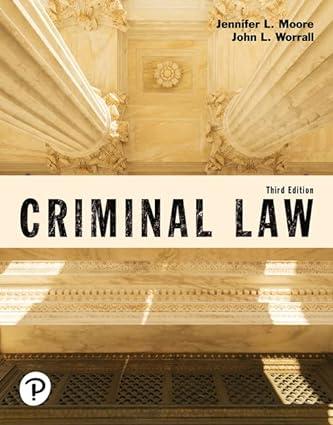Defendant was convicted in the Circuit Court, Jackson County, of manslaughter of elderly burglary victim who died
Question:
Defendant was convicted in the Circuit Court, Jackson County, of manslaughter of elderly burglary victim who died of fatal cardiac dysrhythmia. Defendant appealed.
The District Court of Appeal affirmed.
Appellant, Albert Tyus, appeals from his conviction for manslaughter. Appellant contends that his act of burglarizing an elderly woman’s residence did not constitute the legal cause of the resident’s death by fatal cardiac dysrhythmia and that the trial court therefore erred in denying his Motion for Judgment of Acquittal. Because the State presented legally sufficient evidence during the trial to support each element of manslaughter, including the legal causation element, we affirm appellant’s conviction for manslaughter.
. . . On February 6, 2001, appellant walked to the front of the residence of an elderly woman (“victim”), picked up a chair from the front porch, and broke the window panes in the front door. Upon breaking the glass, appellant saw the victim fall as she was walking towards her back door and heard her scream.
Appellant proceeded through the front door, walked to the victim’s purse, and took twenty-five dollars and the victim’s car keys from inside the purse. Appellant then drove to a separate residence to purchase crack cocaine. Thereafter, appellant returned the victim’s vehicle to her garage, walked through the back door of the residence, placed the keys back into the victim’s purse, and tried to revive the victim to no avail.
. . . During the trial, the victim’s internist opined that the victim died of an arrhythmia related to heart disease.
According to the internist, the stress and excitement brought on by being surprised by an intruder could have caused the condition. The forensic pathologist who conducted the victim’s autopsy opined that the cause of the victim’s death was atherosclerotic and hypertensive heart disease with the contributing factor of stress due to a burglary that caused a fatal cardiac dysrhythmia. The pathologist further testified that the manner of the victim’s death was a homicide; the victim suffered from a natural condition aggravated by stresses that were due to an unnatural event, the burglary, which led to an unnatural death.
. . . Appellant asserts that the trial court erred in denying his Motion for Judgment of Acquittal as the State did not present legally sufficient evidence to prove that appellant’s act of burglarizing the victim’s home constituted the legal cause of the victim’s death . . . The two affirmative elements of manslaughter are the killing and a causative link between the death and the act, procurement, or culpable negligence of the defendant.
In addition to establishing causation in fact, the State must prove that the defendant’s conduct was the legal or proximate cause of the harm at issue. The two questions that must be considered in establishing legal causation are: (1) whether the prohibited result of the defendant’s conduct is beyond the scope of any fair assessment of the danger created by the defendant’s conduct and (2) whether it would be otherwise unjust, based on fairness and policy considerations, to hold the defendant criminally responsible for the prohibited result.
Expert medical testimony as to the likelihood or probability of a causal connection between the defendant’s act and the victim’s death is generally sufficient to establish causation.
Here, we agree with the trial court that the evidence was legally sufficient to establish a jury question as to legal causation.
In doing so, we note that courts in other jurisdictions have recognized that, under circumstances similar to the instant case, the causal relationship between the defendant’s felonious criminal conduct and the victim’s fatal heart attack was not too remote to form a basis for legal causation and, thus, criminal responsibility. For instance, in State v. Losey, 23 Ohio App.3d 93 (1985), the appellant was convicted of involuntary manslaughter and aggravated burglary after he forcibly opened the elderly victim’s front door at 11:00 p.m., after receiving no response from knocking, and attempted to remove a bicycle. Upon hearing an approaching vehicle, the appellant placed the bicycle beside the front door and departed, leaving the front door open.
Both the victim and her son proceeded to the living room and noticed the open front door. The victim subsequently collapsed and later died of an acute coronary thrombosis precipitated by the appellant’s act of burglarizing the victim’s residence. In affirming the judgment, the Ohio Tenth District Court of Appeals concluded that the causal relationship between the appellant’s criminal conduct and the victim’s death was not too improbable, remote, or speculative to form a basis for criminal responsibility.
As in Losey, we conclude that the relationship between appellant’s criminal conduct and the victim’s death was not too improbable, remote, or speculative to form a basis for criminal responsibility . . . Furthermore, it is not unjust in the instant case to hold appellant criminally liable for the victim’s death . . . Therefore, because the State presented legally sufficient evidence to support every element of the crime of manslaughter, the trial court did not err in denying appellant’s Motion for Judgment of Acquittal. Accordingly, we affirm appellant’s conviction for manslaughter.
AFFIRMED.
Questions:-
1. What is the defendant’s legal argument?
2. Explain the court’s test for proximate cause.
Step by Step Answer:






